
This is the first of a series of articles exploring the scientific deep state. Here, Dr. J Scott Turner will explore basic questions, including how many scientists are employed by the federal government, where they work, what they do, and what are their qualifications? Articles to come will present case studies of how the scientific deep state operates, and how it has become politicized.
The deep state is a moniker for an elaborate web of individuals and agencies that act as an unelected and unaccountable fourth branch of government.
This was most prominently on display during the Trump administration, where his populist agenda was thwarted at nearly every turn by an entrenched bureaucracy, collusion between the press and social media, and abdication of governance and lack of oversight by the elected branches of government.
Yet, the elements of a deep state may be found everywhere our bloated government operates, and this includes the sciences. In 2022, the United States government spent roughly $200 billion on research and development. This buys employment for a lot of scientists, large numbers of whom are employed by the numerous federal agencies that support internal research programs. This raises the question: is there a scientific deep state?
In recent years, the spectacular failures of government scientists’ response to the COVID-19 pandemic inflamed suspicions that there is indeed a scientific deep state, one interested only in self-perpetuation and aggrandizement. Not only did government scientists promote faulty or wrong information, but they also engaged in active suppression campaigns (with the active collusion of government scientists with major media outlets) against scientists who differed publicly from them.
This sounds a lot like the behavior of a scientific deep state, which seems to be driving us toward various manners of nonsense, all supposedly backed up by “The Science,” which is mostly trivial, faulty, ill-conceived, fraudulent, and often downright wrong. This “science” seems increasingly to be motivating policies that few people want, that are of doubtful value, and that work against the interests of the public that scientists are supposed to serve.
The Scientific Civil Service
Of the more than two million federal civil servants, about 350,000 are employed in STEM fields (Table 1). About 130,000 of these are employed as scientists (the S in STEM), as opposed to Technology (the T) Engineering (the E), and Mathematics (the M). STEM civil service salaries add up to about a $4 billion annual expenditure, with $1.4 billion going to scientists. For comparison, there are about 42,000 scientists currently employed at some professorial rank in universities and colleges.

The Office of Personnel Management (OPM) identifies more than sixty STEM occupational categories. Among the top twenty categories, the largest contingent by far (nearly 25,000) are employed in the category General Natural Resources Management & Biological Sciences (GNRM & BS; Figure 1). This is a grab-all category where the qualification is any degree in “biological sciences, agriculture, natural resource management, chemistry, or related disciplines appropriate to the position,” or equivalent experience and course work. Below that category, the number of scientists employed dwindles rapidly, even though the aggregate number still is in the tens of thousands (Figure 1).
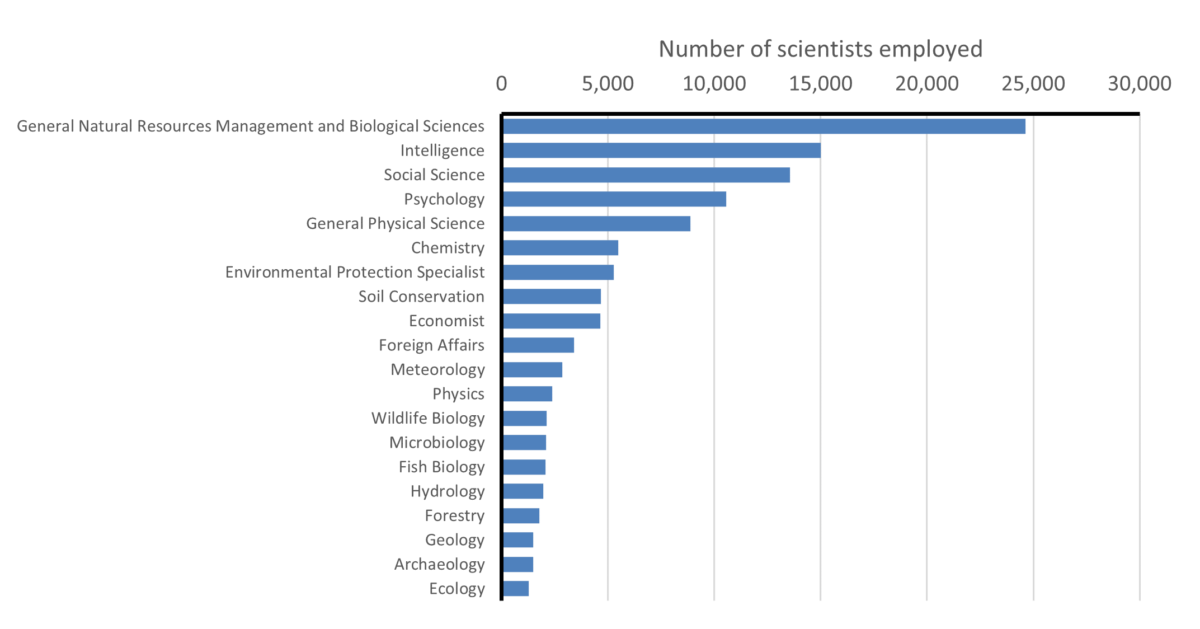
Every cabinet department except for the Treasury has scientific civil servants on their staffs (Figure 2). Agriculture employs the most (about 18,000). The military branches and Defense department also employ substantial numbers of scientists (a little over 39,000 in aggregate). Roughly 14,000 scientists are employed by the Interior Department, which oversees the Fish and Wildlife Service (FWS) and the Geological Survey (USGS). Commerce employs roughly 7,500 scientists in several agencies, including the National Oceanic and Atmospheric Administration (NOAA), and the National Institute of Standards and Technology (NIST).
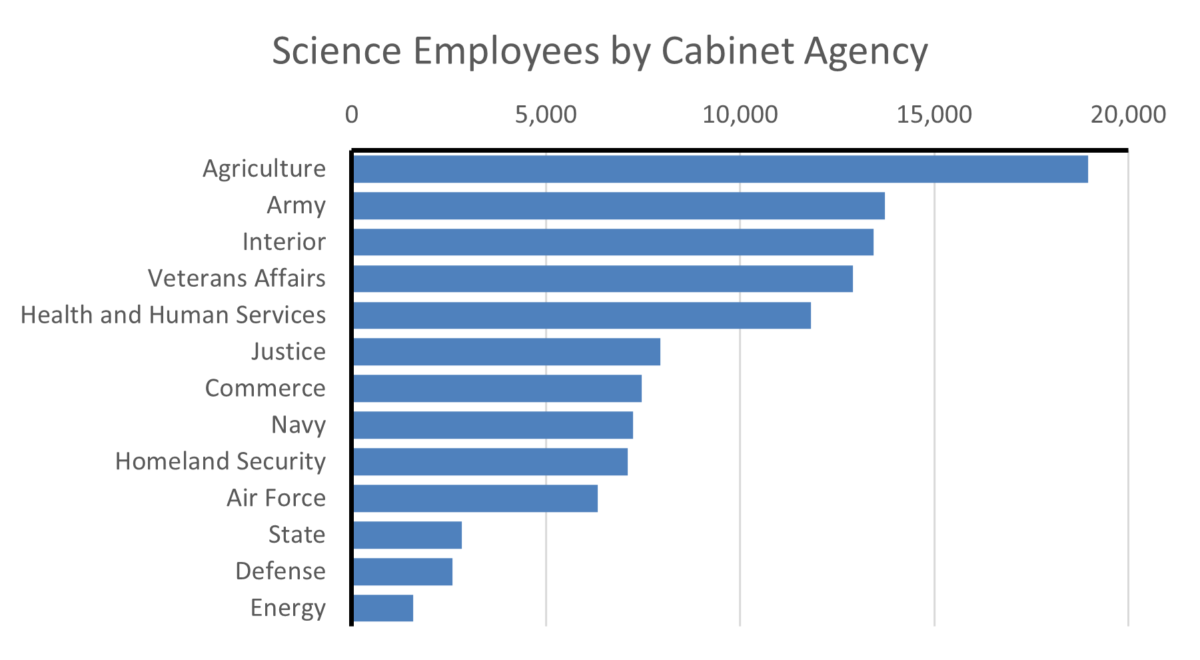
Scientists are also employed in the so-called Large Independent Agencies (Figure 3), which are established by Congress as semi-autonomous bodies answerable to an Inspector General. Of these, the largest employer of scientists by far is the Environmental Protection Agency (EPA), which has about 6,800 scientists on its staff, more than six times the number for the National Aeronautics and Space Administration (NASA).
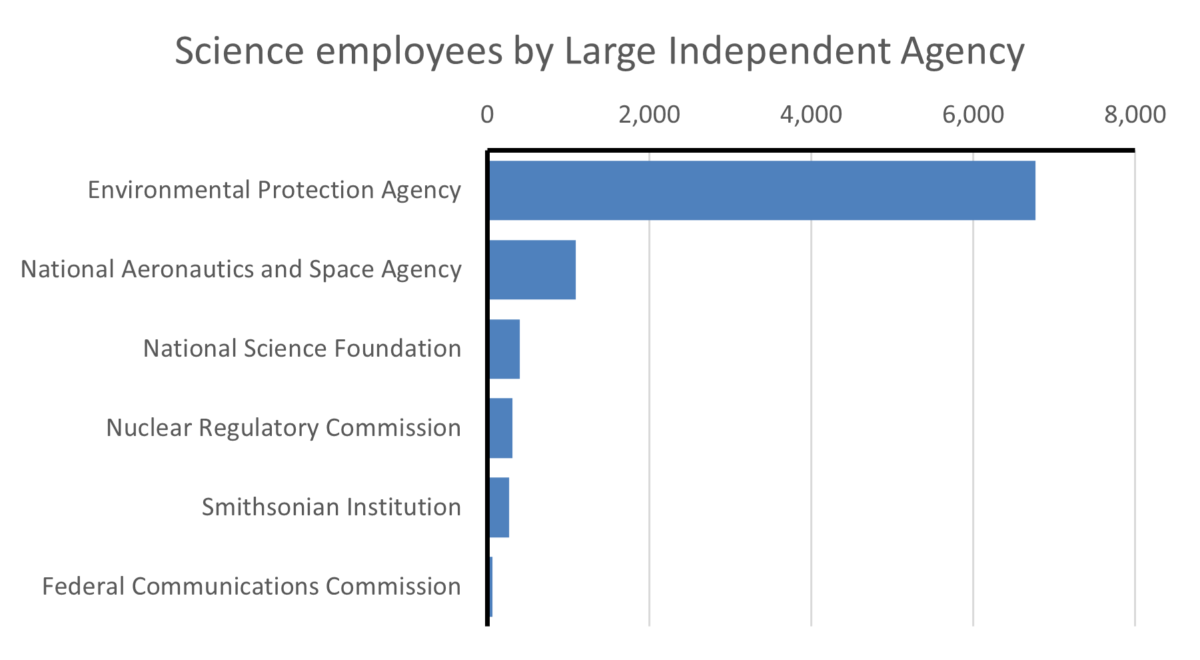
Qualification requirements for employment in the science bureaucracy varies widely (Figure 4). A small, but significant contingent, has a high school diploma only. The largest category (about 35%) have a bachelor’s degree or are working toward one (i.e., they are enrolled in a baccalaureate degree program). The majority of scientific civil servants have, or are working toward, a graduate degree (Masters or Doctoral).
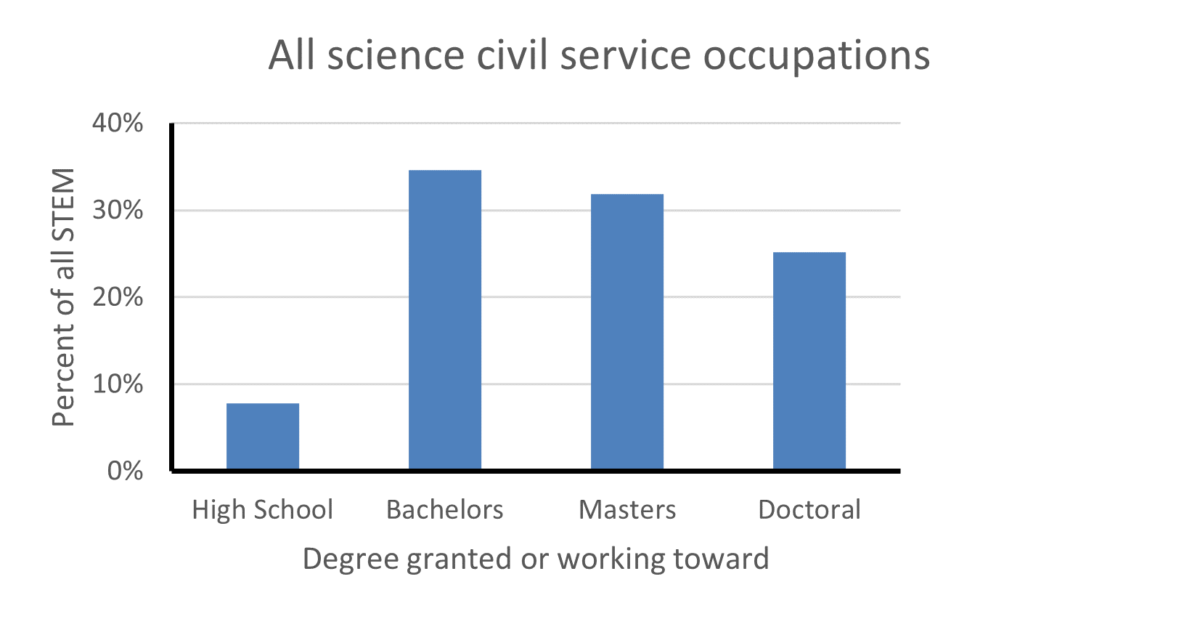
The distribution of qualifications varies widely between occupations (Figure 5). For the GNRM & BS category (the STEM occupation that represents the most numerous category; Figure 1), some 40% hold, or are working toward a high school diploma or a bachelor’s degree. Psychology employs the largest percentage of doctorate holders. Interestingly, the category where the high school diploma is the highest credential obtained is Intelligence, followed closely by Environmental Protection Specialist.
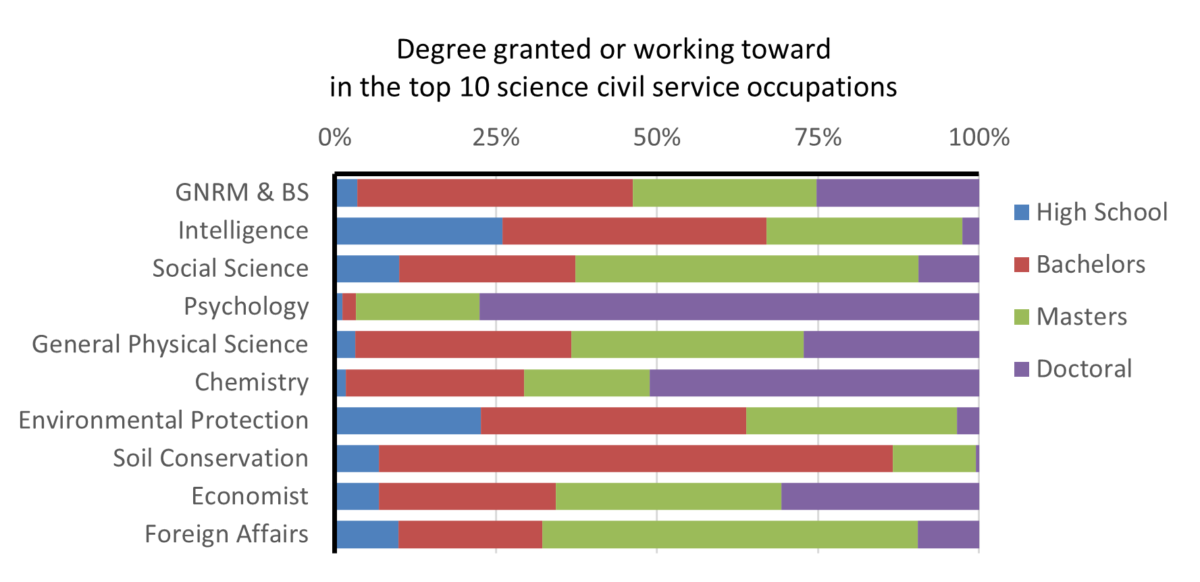
The so-called “hard sciences” employ the fewest number of scientists, but these are more highly credentialed compared to the most scientific civil servants (Figure 1). These mostly hold graduate degrees heavily weighted toward the doctoral degree (Figure 6).
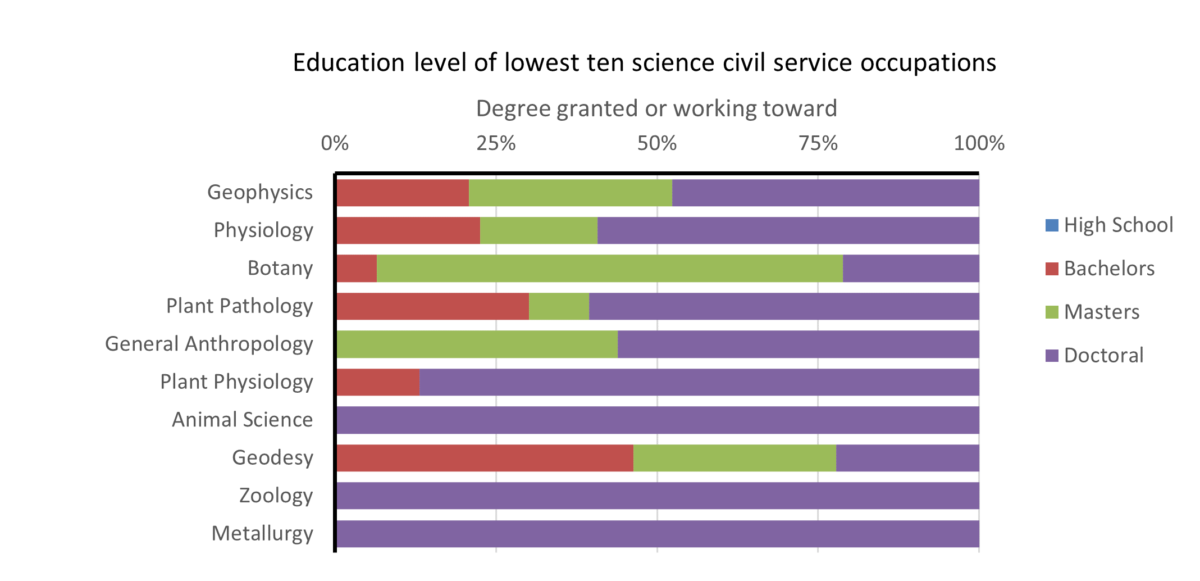
What should the scientific civil service do?
The aim of the civil service is to carry out the work of government.
Employees are required to do this work, and this requires a regime for hiring and dismissing them. The program for civil service employment has always oscillated between patronage for political allies and independence from the ebb and flow of political fortune. Patronage appointments (the “spoils system”) is what enables elected officials to implement their agendas. Independence, as expressed by George Friedman, is intended to “limit the power of the president.”
The problem with the latter view, as is becoming increasingly evident, is that a nominally independent civil service can become an unaccountable fourth branch of government, which the larger it grows, the more it makes a mockery of our representative democracy. The problem is exacerbated when this fourth branch becomes a political monoculture that has been captured by one political party.
What of the scientific civil service? The raison d’etre of a scientific civil service is to provide dispassionate and objective evidence to legislatures so that they may make rational and informed policy. If a government has an electoral mandate to manage wetlands, for example, there should be informed scientific advice on how to accomplish this. This advice, being scientific, should be independent of political ideology.
In the case of wetlands management, however, politics may be playing more of a role than it ideally should. In the original legislation to protect wetlands, for example, the act’s statement of purpose focused on flood control, protecting habitats for migratory birds, flood control, and water quality. A search of the literature shows a recent uptick in emphasizing wetlands management being marshaled to “help climate change.” This was not one of the stated intentions of the legislation, so the question must be asked: by what authority is wetlands management being redirected to fighting climate change? Is this science directing policy, or politics directing science: “policy-based evidence-making?” Given that the uptick began in the current administration, the suspicion is strong that it is being driven by the Biden administration’s political determination to declare a “climate emergency.” If so, it is the army of scientific bureaucrats that will bolster the agenda of an administration that aligns with them politically. Contrast this with the collective freakout over a president whose political alignment was at odds with the scientific deep state’s.
Photo by Regina — Adobe Stock — Asset ID#: 641668640
While problematic — it led to the assassination of President Garfield in 1881 — Andrew Jackson’s concept of a “Spoils System” where the incoming President gets to fire all Federal employees and replace them with his supporters had some merit.
I think the larger issue is public sector unionization, which both FDR and George Meany opposed. Without that, a President Trump (or Biden) could simply fire the bureaucrats who are unwilling to do what he wants them to do.